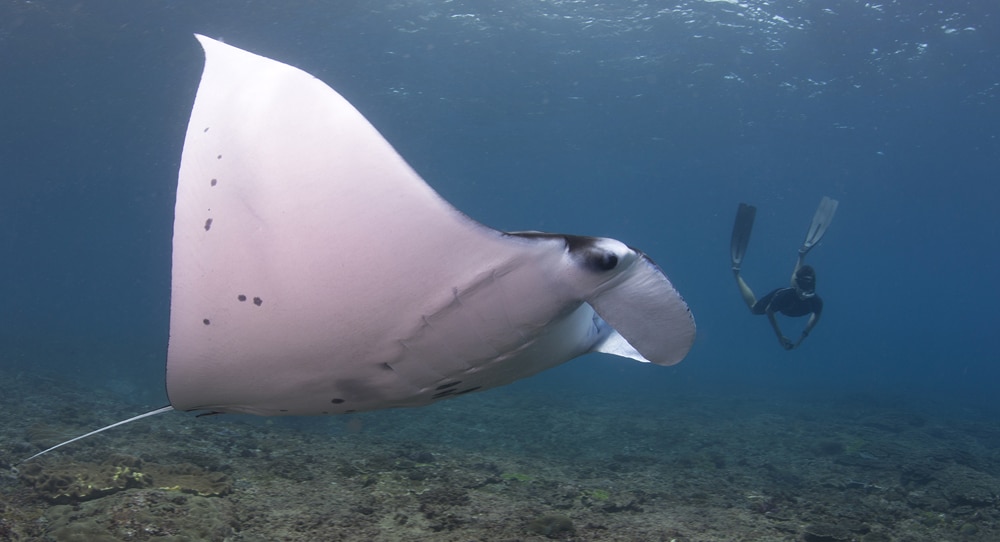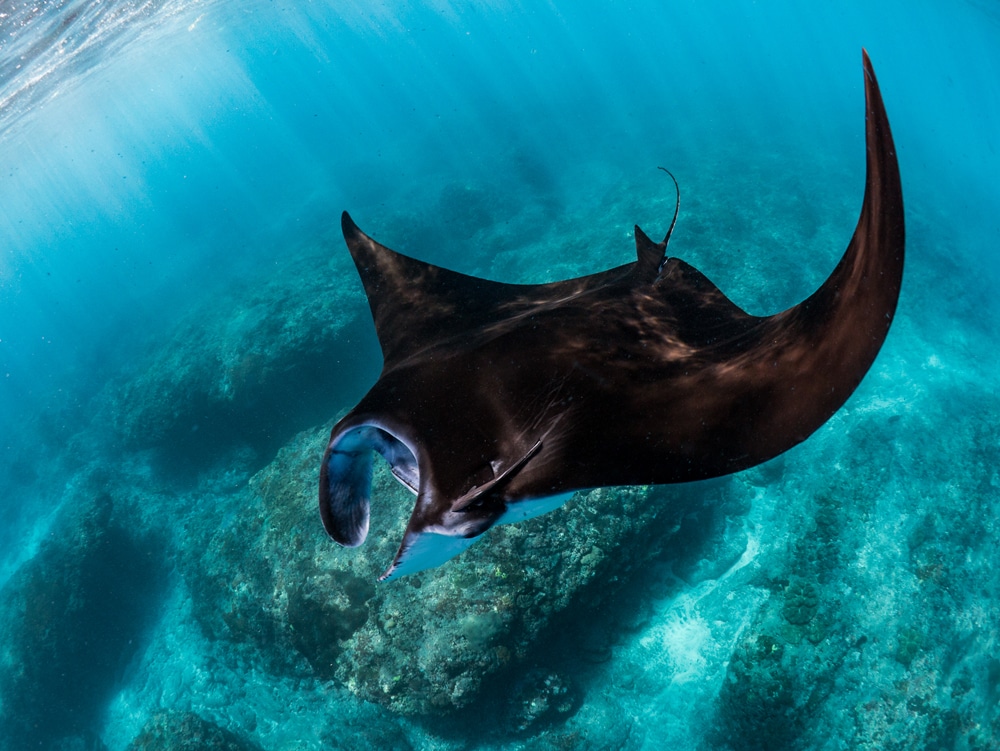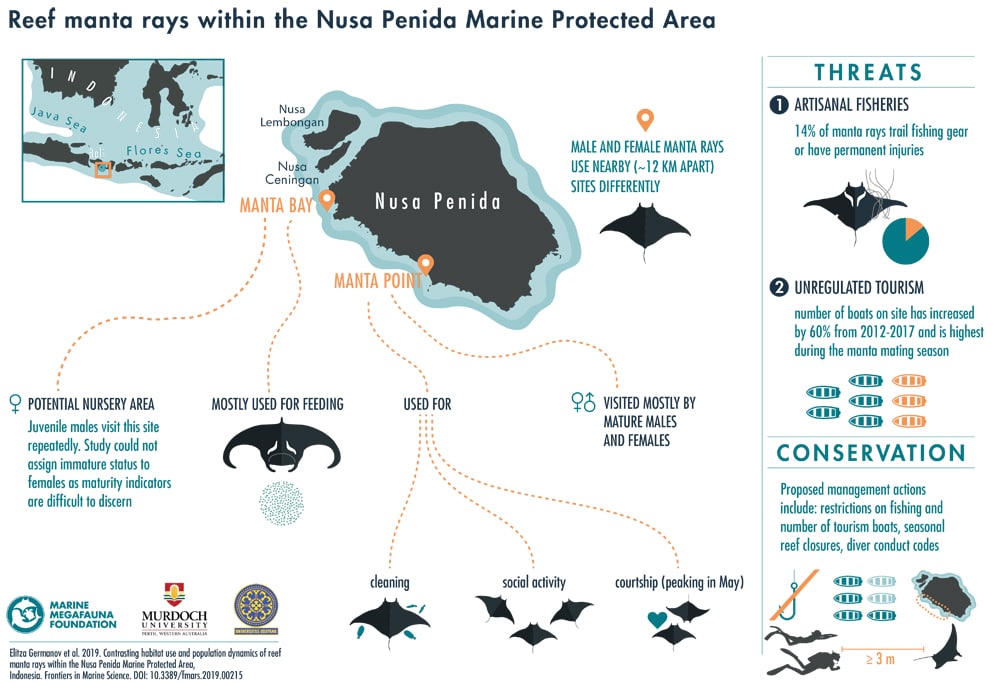News
Tourists key to future of rare manta nursery

 Scientists from the Marine Megafauna Foundation and Murdoch University are reporting a large number of juvenile manta rays in the waters of Nusa Penida, a small island 18km southeast of Bali, suggesting the area may be a nursery for this threatened species.
Scientists from the Marine Megafauna Foundation and Murdoch University are reporting a large number of juvenile manta rays in the waters of Nusa Penida, a small island 18km southeast of Bali, suggesting the area may be a nursery for this threatened species.
Reef mantas (Mobula alfredi), which grow up to 5m, tend to reside and feed in shallow, coastal habitats. They also visit ‘cleaning stations’ on coral reefs to have parasites or dead skin picked off by small fish. In Nusa Penida, they are present year-round making the Marine Protected Area (MPA) a snorkeling and diving hotspot.
One of the popular dive sites (Manta Bay) described in this new study is predominantly frequented by juvenile males looking for food. Some are as small as 1.5m in disc width on first sighting, providing strong evidence that the site forms part of a nursery habitat and foraging ground for the local reef manta population. Most individuals have been seen repeatedly across multiple years.
“Where manta rays are born and grow up still baffles us. Our research in Indonesia suggests there might be a reef manta nursery in the Nusa Penida area and possibly also in the famous Raja Ampat archipelago”, said lead author Elitza Germanov. “It’s really important for us to know where these nurseries are. They provide a safe space for young, vulnerable manta rays to grow and develop away from the reach of predators.”
Interestingly, mature males and females seem to prefer Manta Point, a second dive site a mere 12 km away. Here, the manta rays are mostly observed visiting cleaning stations and engaging in social activity as well as courtship display during the mating season (peaking in May).
Nusa Penida attracts more than 200,000 tourists each year. Of the 11 main dive spots in these waters, Manta Bay and Manta Point are frequented most by tourism operators, putting the local manta ray population under increasing pressure. While manta rays are protected in Indonesia2, there are currently few regulations in place to manage the growing tourism industry. The number of boats allowed to enter manta ray habitats is not limited and codes of conduct for manta ray interactions are voluntary. The average annual number of boats present at the two manta ray sites has increased by 60% since 2012 and tourism is highest during the mating season.
Germanov commented: “Large diving groups and boat engine noise can cause chronic stress to these vulnerable animals. Tourists may disrupt the foraging, cleaning and mating behavior of manta rays if they get too close, which can have serious implications for their growth and fitness.”
Limiting the number of tourism vessels allowed at one time and making codes of conduct for diving and snorkeling with manta rays mandatory are proposed as a way to minimize the impact from tourism. Seasonal closure of Manta Point could also be considered to protect the manta rays from disturbance during the mating period.
Artisanal fishing poses a further threat to the local population. During the study, 14% of manta rays were either trailing hooks and lines or had injuries and even amputations from fishing gear cutting through their skin and cartilage skeleton. While all fishing activities are officially prohibited in both Manta Bay and Manta Point, the whole west coast of Nusa Penida could be closed off as a precautionary measure.
Dr Andrea Marshall, principal scientist and co-founder of the Marine Megafauna Foundation said: “This is clearly an important habitat for reef mantas. In fact, the resighting rates in the Nusa Penida MPA are higher than anywhere else in the world.
“The two aggregation sites are very close to each other but used for different purposes. We still don’t know much about when and how the mantas move between the feeding, cleaning and mating grounds. Putting the pieces of this puzzle together will help us figure out how to protect these slow-growing animals.”
For more information about the work of the Marine Megafauna Foundation visit their website by clicking here.
Gear News
Introducing the TR-80, IR-50 and CS-30 Regulators from DYNAMICNORD

Whether you are a beginner or a professional diver – with the three new main regulators from DYNAMICNORD, everyone will find their favourite regulator. They all look super stylish.
Excellent performance with the TR-80
Quality and performance are the be-all and end-all for regulators. It is not for nothing that the TR stands for Tec Reg. The innovative design of the TR-80 guarantees absolute reliability – even in ice-cold waters.

Perfect breathing effort at 0.8 J/l / certified for diving in waters below 10 degrees / structural design made of solid brass for best cold protection / membrane-compensated design with dry seal of the first stage / reduced exhalation effort thanks to optimized exhalation membrane and bubble deflector / adjustable Venturi (dive/predive) and adjustment knob for individual inhalation comfort / innovative design of the front cover prevents free-flow in strong currents or when diving with scooters / design made of sandblasted brass, matt chrome finish / 2 HP and 4 LP outlets / mouthpiece made of high-quality, anti-allergic silicone for maximum comfort.


Amazing underwater adventures with the IR-50
The IR-50 is the top regulator for advanced and experienced divers. Natural breathing is the essence of this regulator.

Ideal breathing effort at 0.8 J/l /certified for diving in waters below 10 degrees / compensated membrane / adjustable venturi (dive/predive) and adjustment knob for individual inhalation comfort/ outlet valve and deflector for minimum exhalation effort and reduction of bubbles on the face / design made of sandblasted brass, matt chrome finish / 2 HP and 4 NP outlets / mouthpiece made of high-quality, anti-allergic silicone for maximum comfort.


The Workhorse – our CS-30
For diving centres and diving beginners – the workhorse stands for strong construction, reliability and robustness. Perfect for your training.

Optimal breathing effort at 0.8 J/l /recommended for diving in waters above 10 degrees / non-compensated piston / adjustable venturi (dive/predive) / outlet valve and deflector for minimum exhalation effort and reduction of bubbles on the face / design made of sandblasted brass, matt chrome finish / 1 HP and 3 NP outlets / mouthpiece made of high-quality, anti-allergic silicone for maximum comfort.


Octopus OP-30
The OP-30 is the ideal addition to all DYNAMICNORD regulators. It is identical in construction to the CS-30.

The TR-80, IR-50, CS-30 (DIN & INT) regulators and the Octopus OP-30 are available from DYNAMICNORD dealers and in the online store.
DYNAMICNORD – Your Outdoor Companion.
Marine Life & Conservation
Paul Watson Released as Denmark Blocks Japan’s Extradition Bid

Renowned anti-whaling activist Paul Watson has been released from custody in Greenland after spending five months in detention. Denmark’s Justice Ministry rejected Japan’s request for his extradition, citing insufficient guarantees that his time already served in custody would be credited against any potential sentence.
The 74-year-old Canadian-American was arrested on July 21 in Nuuk, Greenland’s capital, when his ship docked to refuel. His arrest was based on a 2012 Japanese warrant related to a 2010 encounter in Antarctic waters. Japan alleged Watson obstructed operations and caused damage to a whaling research ship during efforts to disrupt illegal whaling. Watson has consistently denied these claims, maintaining his commitment to marine conservation.
Denmark, which oversees extradition matters for Greenland, concluded that while the legal conditions for extradition were met, the lack of assurances from Japan regarding time-served credit made extradition untenable.
In a video shared by his foundation, Watson expressed gratitude and relief, saying, “After five months, it’s good to be out… and good to know they’re not sending me to Japan.” He added that the most difficult part of his time in custody was being separated from his two young sons.
Watson is a pioneering figure in marine conservation, known for founding the Captain Paul Watson Foundation in 2022 after decades of activism with the Sea Shepherd Conservation Society. His bold efforts to defend marine life have earned him widespread support, including from celebrities and conservationists. His work has also been featured in the acclaimed reality TV series Whale Wars.
Watson’s lawyer, Jonas Christoffersen, praised the decision, stating, “We are happy and relieved that Paul Watson is now free.” He added that Watson is eager to reunite with his family and continue his vital work.
The arrest occurred while Watson’s vessel, the M/Y John Paul DeJoria, was en route to the North Pacific with a team of 26 volunteers to intercept a Japanese whaling ship. His foundation described the arrest as politically motivated and emphasized that Watson’s actions were focused on ending illegal whaling practices.
Japan resumed commercial whaling in 2019 after leaving the International Whaling Commission, asserting that whale meat is a cultural tradition. Conservationists, however, continue to challenge these practices, highlighting their impact on marine ecosystems.
Despite the challenges, Watson remains steadfast in his mission to protect marine life and bring attention to whaling practices. His dedication to ocean conservation has made him a globally respected advocate for the environment.
-

 News2 months ago
News2 months agoIconic SS United States to become the World’s Largest Artificial Reef
-

 News3 months ago
News3 months agoBook Review – 52 Assignments: Underwater Photography
-

 Gear News3 months ago
Gear News3 months agoDYNAMICNORD – New German diving brand enters the British market
-

 News3 months ago
News3 months agoExploring Cenote El Pit: A Diver’s Dream
-

 Gear News3 months ago
Gear News3 months agoTry BARE drysuits (and maybe even win one!) this Friday with Sea & Sea at North West Dive Fest
-

 Marine Life & Conservation3 months ago
Marine Life & Conservation3 months agoBook Review: Coral Triangle Cameos
-

 Blogs2 months ago
Blogs2 months agoDive the Egyptian Red Sea this Autumn with Regaldive
-

 News3 months ago
News3 months ago2024 Ocean Art Underwater Photo Competition Announced

















